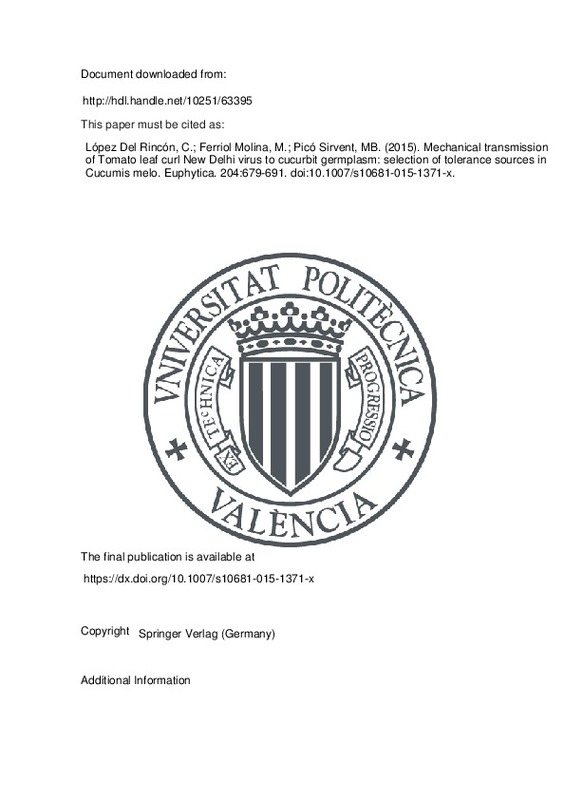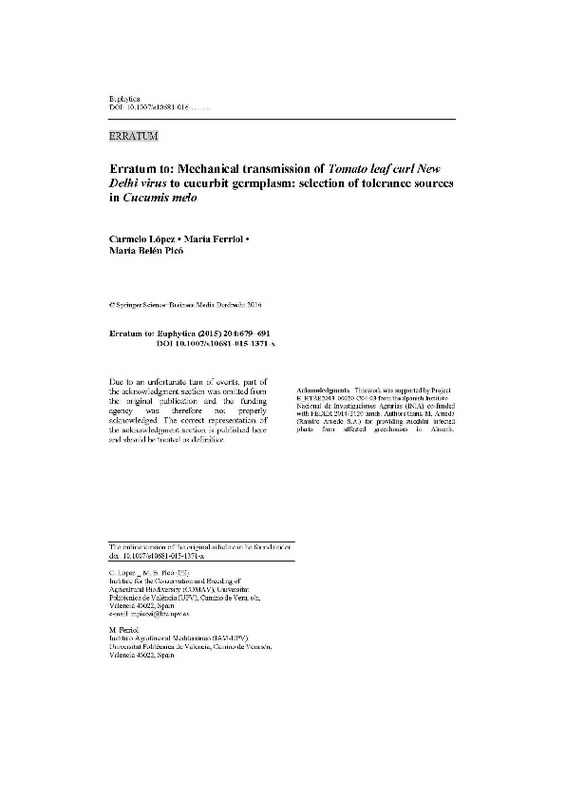JavaScript is disabled for your browser. Some features of this site may not work without it.
Buscar en RiuNet
Listar
Mi cuenta
Estadísticas
Ayuda RiuNet
Admin. UPV
Mechanical transmission of Tomato leaf curl New Delhi virus to cucurbit germplasm: selection of tolerance sources in Cucumis melo
Mostrar el registro sencillo del ítem
Ficheros en el ítem
| dc.contributor.author | López Del Rincón, Carmelo
|
es_ES |
| dc.contributor.author | Ferriol Molina, María
|
es_ES |
| dc.contributor.author | Picó Sirvent, María Belén
|
es_ES |
| dc.date.accessioned | 2016-05-03T08:30:05Z | |
| dc.date.available | 2016-05-03T08:30:05Z | |
| dc.date.issued | 2015-08 | |
| dc.identifier.issn | 0014-2336 | |
| dc.identifier.uri | http://hdl.handle.net/10251/63395 | |
| dc.description.abstract | [EN] Cucurbits are major crop species, including fruits and vegetables cultivated worldwide that supply essential vitamins and minerals to current diets in developed and developing countries. Viral diseases are main factors affecting cucurbits cultivation. The most widespread and damaging have been aphidborne viruses belonging to the Potyviridae family. Whitefly-transmitted begomoviruses (Geminiviridae) have been identified more recently in different cucurbit species. A severe outbreak of Tomato leaf curl New Delhi virus (ToLCNDV) occurred in pumpkins and melons in the main production area of Southern Spain in 2012 2014. We developed a mechanical inoculation method to facilitate the screening of germplasm against this virus. Mechanical transmission with this method was confirmed in 4 genera and 13 species of the family, including the main crops, cucumber, melon, watermelon and pumpkins, and also crop related exotic germplasm (landraces and wild species) used for cucurbits breeding. Diversity in the response was observed within and among species. Tolerance to mechanical transmission of ToLCNDV was identified in melon, within Cucumis melo subsp. agrestis var. momordica and in wild agrestis accessions. All the tolerant accessions came from India, the country in which this virus was firstly reported. Some of these accessions have been previously reported to be tolerant or resistant to other viruses and as they are fully crossable to commercial melons, they are good sources to develop new melon varieties with tolerance to ToLCNDV. | es_ES |
| dc.description.sponsorship | This work was supported by Project E_RTAE2013-00020-C04-03 from the Spanish Instituto Nacional de Investigaciones Agrarias (INIA). Authors thank M. Arnedo (Ramiro Arnedo S.A.) for providing zucchini infected plants from affected greenhouses in Almeria. | en_EN |
| dc.language | Inglés | es_ES |
| dc.publisher | Springer Verlag (Germany) | es_ES |
| dc.relation.ispartof | Euphytica | es_ES |
| dc.rights | Reserva de todos los derechos | es_ES |
| dc.subject | Cucurbitaceae | es_ES |
| dc.subject | Begomovirus | es_ES |
| dc.subject | ToLCNDV | es_ES |
| dc.subject | Melon | es_ES |
| dc.subject | Resistance Breeding | es_ES |
| dc.title | Mechanical transmission of Tomato leaf curl New Delhi virus to cucurbit germplasm: selection of tolerance sources in Cucumis melo | es_ES |
| dc.type | Artículo | es_ES |
| dc.identifier.doi | 10.1007/s10681-015-1371-x | |
| dc.relation.projectID | info:eu-repo/grantAgreement/MINECO//RTA2013-00020-C04-03/ES/Identificación de resistencias a ToLCNDV en Cucurbitáceas y análisis genético de las mismas/ | es_ES |
| dc.rights.accessRights | Abierto | es_ES |
| dc.contributor.affiliation | Universitat Politècnica de València. Instituto Universitario de Conservación y Mejora de la Agrodiversidad Valenciana - Institut Universitari de Conservació i Millora de l'Agrodiversitat Valenciana (COMAV) | es_ES |
| dc.contributor.affiliation | Universitat Politècnica de València. Instituto Agroforestal Mediterráneo - Institut Agroforestal Mediterrani | es_ES |
| dc.description.bibliographicCitation | López Del Rincón, C.; Ferriol Molina, M.; Picó Sirvent, MB. (2015). Mechanical transmission of Tomato leaf curl New Delhi virus to cucurbit germplasm: selection of tolerance sources in Cucumis melo. Euphytica. 204:679-691. https://doi.org/10.1007/s10681-015-1371-x | es_ES |
| dc.description.accrualMethod | S | es_ES |
| dc.relation.publisherversion | https://dx.doi.org/10.1007/s10681-015-1371-x | es_ES |
| dc.description.upvformatpinicio | 679 | es_ES |
| dc.description.upvformatpfin | 691 | es_ES |
| dc.type.version | info:eu-repo/semantics/publishedVersion | es_ES |
| dc.description.volume | 204 | es_ES |
| dc.relation.senia | 291579 | es_ES |
| dc.identifier.eissn | 1573-5060 | |
| dc.contributor.funder | Ministerio de Economía y Competitividad | es_ES |
| dc.description.references | Álvarez JM, González-Torres R, Mallor C (2005) Potential sources of resistance to Fusarium wilt and powdery mildew in melons. HortScience 40:1657–1660 | es_ES |
| dc.description.references | Bandaranayake WMEK, Wickramarachchi WART, Wickramasinghe HAM, Rajapakshe RGAS, Dissanayake DMKK (2014) Molecular detection and characterization of begomoviruses associated with cucurbitaceae vegetables in Skingri Lanka. J Natl Sci Found Sri Lanka 42:239–245 | es_ES |
| dc.description.references | Chang HH, Ku HM, Tsai WS, Chien RC, Jan FJ (2010) Identification and characterization of a mechanical transmissible begomovirus causing leaf curl on oriental melon. Eur J Plant Pathol 127:219–228 | es_ES |
| dc.description.references | Dhillon NPS, Monforte AJ, Pitrat M, Pandey S, Singh PK, Reitsma KR, Garcia-Mas J, Sharma A, McCreight JD (2012) Melon landraces of India: contributions and importance. In: Janick J (ed) Plant Breeding Rev. Wiley, Hoboken, pp 85–150 | es_ES |
| dc.description.references | Doyle JJ, Doyle JL (1990) Isolation of plant DNA from fresh tissue. Focus 12:13–15 | es_ES |
| dc.description.references | Fauquet CM, Briddon RW, Brown JK, Moriones E, Stanley J, Zerbini M, Zhou X (2008) Geminivirus strain demarcation and nomenclature. Arch Virol 153:783–821 | es_ES |
| dc.description.references | Fernández-Trujillo JP, Picó B, García-Mas J, Álvarez JM, Monforte AJ (2011) Breeding for fruit quality in melon. In: Jenks MA, Bebeli PJ (eds) Breeding for fruit quality. Wiley, Hoboken | es_ES |
| dc.description.references | Ferriol M, Picó B (2008) Pumpkin and winter squash. In: Prohens J, Nuez F (eds) Handbook of plant breeding, vol 1., Vegetables ISpringer, Heidelberg, pp 317–349 | es_ES |
| dc.description.references | Islam S, Munshi AD, Verma M, Arya L, Mandal B, Behera TK, Kumar R, Lal SK (2010) Genetics of resistance in Luffa cylindrica Roem. against tomato leaf curl New Delhi virus. Euphytica 174:83–89 | es_ES |
| dc.description.references | Islam S, Munshi AD, Verma M, Arya L, Mandal B, Behera TK, Kumar R, Lal SK (2011) Screening of Luffa cylindrica Roem. for resistance against Tomato leaf curl New Delhi Virus, inheritance of resistance, and identification of SRAP markers linked to the single dominant resistance gene. J Hortic Sci Biotechnol 86:661–667 | es_ES |
| dc.description.references | Ito T, Sharma P, Kittipakorn K, Ikegami M (2008) Complete nucleotide sequence of a new isolate of Tomato leaf curl New Delhi virus infecting cucumber, bottle gourd and muskmelon in Thailand. Arch Virol 153:611–613 | es_ES |
| dc.description.references | Juárez M, Legua P, Mengual CM, Kassem MA, Sempere RN, Gómez P, Truniger V, Aranda MA (2013) Relative incidence, spatial distribution and genetic diversity of cucurbit viruses in eastern Spain. Ann Appl Biol 162:362–370 | es_ES |
| dc.description.references | Juárez M, Tovar R, Fiallo-Olivé E, Aranda MA, Gosálvez B, Castillo P, Moriones E, Navas-Castillo J (2014) First detection of Tomato leaf curl New Delhi virus infecting Zucchini in Spain. Plant Dis 98:857–858 | es_ES |
| dc.description.references | Jyothsna P, Haq QMI, Singh P, Sumiya KV, Praveen S, Rawat R, Briddon RW, Malathi VG (2013) Infection of tomato leaf curl New Delhi virus (ToLCNDV), a bipartite begomovirus with betasatellites, results in enhanced level of helper virus components and antagonistic interaction between DNA B and betasatellites. Appl Microbiol Biotechnol 97:5457–5471 | es_ES |
| dc.description.references | Khan MS, Ji SH, Chun SC (2012) Begomoviruses and their emerging threats in South Korea: a review. Plant Pathol J 28:123–136 | es_ES |
| dc.description.references | King SR, Davis AR, Zhang XP, Crosby K (2010) Genetics, breeding and selection of rootstocks for Solanaceae and Cucurbitaceae. Sci Hortic 127:106–111 | es_ES |
| dc.description.references | Munera M, Giné A, Pocurull M, Picó B, Gisbert C, Sorribas FJ (2014) Comportamiento de líneas de Cucumis metuliferus, Citrullus lanatus var. citroides y C. colocynthis frente a Meloidogyne spp. Como potenciales portainjertos de melón, pepino y sandía. XVII Congreso de la Sociedad Española de Fitopatología 7–10 de octubre de 2014 | es_ES |
| dc.description.references | Navas-Castillo J, López-Moya JJ, Aranda MA (2014) Whitefly-transmitted RNA viruses that affect intensive vegetable production. Ann Appl Biol 165:155–171 | es_ES |
| dc.description.references | Papidam M, Beachy RN, Fauquet CM (1995) Tomato leaf curl geminivirus from India has a bipartite genome and coat protein is not essential for infectivity. J Gen Virol 76:25–35 | es_ES |
| dc.description.references | Paris HS (2008) Summer Squash. In: Prohens J, Nuez F (eds) Handbook of plant breeding, vol 1., Vegetables ISpringer, Heidelberg, pp 351–379 | es_ES |
| dc.description.references | Paris HS, Brown RN (2005) The genes of pumpkin and squash. HortScience 40:1620–1630 | es_ES |
| dc.description.references | Paris HS, Kabelka E (2009) Gene list for Cucurbita species, 2009. Cucurbit Genet Coop Rep 31–32:44–69 | es_ES |
| dc.description.references | Picó B, Sifres A, Nuez F (2005) Quantitative detection of cucumber vein yellowing virus in susceptible and partially resistant plants using real-time PCR. J Virol Methods 128:14–20 | es_ES |
| dc.description.references | Pitrat M (2008) Melon. In: Prohens J, Nuez F (eds) Handbook of plant breeding, vol 1., Vegetables ISpringer, Heidelberg, pp 283–315 | es_ES |
| dc.description.references | Roy A, Bal SS, Fergany M, Kaur S, Singh H, Malik AA, Singh J, Monforte AJ, Dhillon NPS (2012) Wild melon diversity in India (Punjab State). Genet Resour Crop Evol 59:755–767 | es_ES |
| dc.description.references | Samretwanich K, Chiemsombat P, Kittipakorn K, Ikegami M (2000) Tomato leaf curl geminivirus associated with cucumber yellow leaf disease in Thailand. J Phytopathol 148:615–617 | es_ES |
| dc.description.references | Sohrab SS, Karim S, Varma A, Abuzenadah AM, Chaudhary AG, Damanhouri GA, Mandal B (2013) Characterization of Tomato Leaf Curl New Delhi Virus infecting cucurbits: evidence for sap transmission in a host specific manner. Afr J Biotechnol 12:5000–5009 | es_ES |
| dc.description.references | Sohrab SS, Karim S, Varma A, Azhar EI, Abuzenadah AM, Mandal B (2014) Sap transmission of Tomato Leaf Curl New Delhi Virus infecting sponge gourd in northern India. J Plant Interact 9:241–248 | es_ES |
| dc.description.references | Srivastava KM, Hallan V, Raizada RK, Chandra G, Singh BP, Sane PV (1995) Molecular cloning of Indian tomato leaf curl virus genome following a simple method of concentrating the supercoiled replicative form of viral DNA. J Virol Methods 51:297–304 | es_ES |
| dc.description.references | Usharani KS, Surendranath B, Paul-Khurana SM, Garg ID, Malathi VG (2004) Potato leaf curl—a new disease of potato in northern India caused by a strain of Tomato leaf curl New Delhi virus. Plant Pathol 53:235 | es_ES |







![[Cerrado]](/themes/UPV/images/candado.png)


